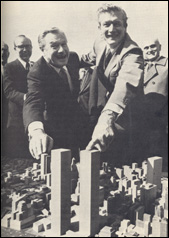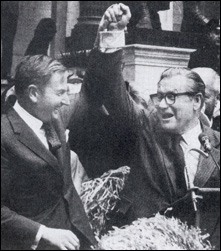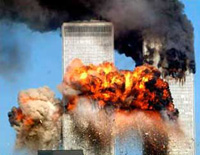"About ten years after it was founded Mr. Thompson and his associates sold the control to the late John G. Moore, Calvan S. Brice, James J. Hill, Gen. Samuel Thomas, and their associates." It opened for business at 117 Broadway; moved to the old Clearing House Building at 15 Nassau Street in 1887; and to the new Clearing House building at 83 Cedar Street in 1895. In 1915, it moved to the Adams Building at 57 Broadway. (The Chase National Enters New Home. New York Times, Jan. 10, 1915.)
From Wikipedia...
Chase National Bank
Chase National Bank was formed in 1877 by John Thompson.[1] It was named for former United States Treasury Secretary and Chief Justice Salmon P. Chase,[3] although Chase did not have a connection with the bank.[1]
The Chase National Bank acquired a number of smaller banks in the 1920s, through its Chase Securities Corporation. In 1926, for instance, it acquired Mechanics and Metals National Bank.
Its most significant acquisition though was the Equitable Trust Company of New York in 1930, the largest stockholder of which was John D. Rockefeller, Jr.[8] This made it the largest bank in America and indeed the world.
Chase was primarily a wholesale bank, dealing with other prominent financial institutions and major corporate clients, such as General Electric, which had, through its RCA affiliate, leased prominent space and become a crucial first tenant of Rockefeller Center, rescuing that major project in 1930. The bank also is closely associated with and has financed the oil industry, having longstanding connections with its board of directors to the successor companies of Standard Oil, especially ExxonMobil, which are also Rockefeller holdings.
View Merchants of Death in a larger map
Standard Oil founder John D. Rockefeller located at 26 Broadway just down the street had his own personal fortune besides Standard Oil (now called ExxonMobil, ConocoPhillips, Chevron, and BP) money which was administered through accounts at Chase National Bank here.
In 1921, John D. Rockefeller Jr. received about 10% of the shares of the Equitable Trust Company from his father, making him the bank's largest shareholder. Subsequently, in 1930, the Equitable merged with the Chase National Bank, now JP Morgan Chase, and became at that time the largest bank in the world. Although his stockholding was reduced to about 4% following this merger, he was still the largest shareholder in what became known as the "Rockefeller bank". As late as the 1960s his family still retained about 1% of the bank's shares, by which time his son David had become the bank's president.[5]
Just before WWII, the Rockefeller’s Chase Bank collaborated with the Nazi’s Schroder Bank to raise $25 million for Germany’s war economy. They also supplied the German government with names and background information on 10,000 fascist sympathizers in America. Throughout WWII, Rockefeller’s Chase Bank stayed open in Nazi-occupied Paris, providing services for Germany’s embassy and its businesses.[1]
The Twin Towers were called David and Nelson Rockefeller!!!
 Governor Nelson Rockefeller (left) with Mayor John Lindsay inspect model of Twin Towers. |  David and Nelson on Wall St. during Nelson's 1970 race for Governor of New York State. |  David Rockefeller was Chairman of Chase Manhattan Bank and provided the finances for the Twin Towers. |
Chase Manhattan was created by the union of the Rockefeller-owned Chase Bank with the Kuhn, Loeb controlled Manhattan Bank.[2]
Chase-Manhattan Bank would give it's presidency to the man who freed Rockefeller collaborators at I.G. Farben after the war.